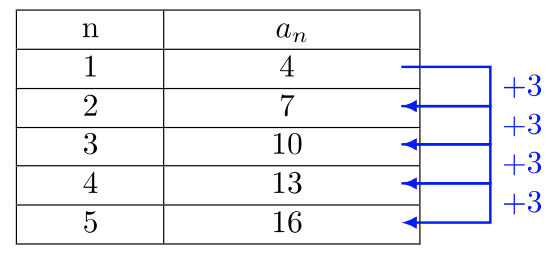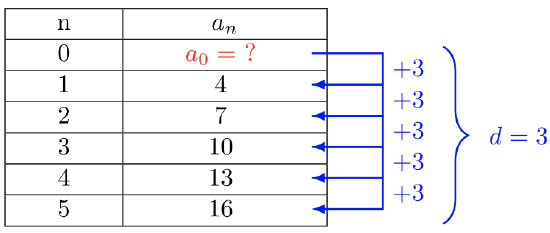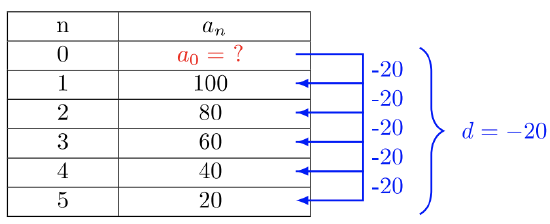8.1: Arithmetic Sequences
- Page ID
- 83157
The following sequence of numbers has a pattern you are bound to recognize:
\(2, 4, 6, 8, 10, 12, 14, 16, 18, …\)
Likely, you would describe the sequence in words: the sequence of even numbers. Alternatively, can we describe the sequence mathematically? That is, can we describe the pattern of the sequence of even numbers using a formula? Absolutely! This section will explore arithmetic sequences, how to identify them, mathematically describe their terms, and the relationship between arithmetic sequences and linear functions. Let’s get started!
A sequence is a list of numbers: \(a_1 , a_2, a_3, a_4 , … , a_n, … \) A sequence can be a finite or infinite list. We call \(a_1\) the first term, \(a_2\) the second term, and \(a_n\) the “general term” or the \(n^{\text{th}}\) term. Sequences have a pattern. We describe the pattern in the general term \(a_n\).
For the sequence of even numbers: \(2, 4, 6, 8, 10, …\) the general term \(a_n = 2n\).

The general term \(a_n\) of a sequence is simply a function of \(n\), indicated above as \(f(n)\), where \(n\) is a natural number (or whole number if \(n\) starts with zero).
In the sequence of even numbers, what is the \(20^{\text{th}}\) term in the sequence?
Solution
The general term of the sequence of even numbers is \(a_n = 2n\). Since \(n =\) the term number, we are asked to find \(a_{20}\).
\(\begin{array}&& a_{20} = 2(20) = 40 &\text{Plug in the term-number \(n=20\) into the formula \(a_n=2n\)} \end{array}\)
Answer The \(20^{\text{th}}\) term of the sequence of even numbers is the number \(40\).
If the sequence: \(a_1, a_2, a_3, a_4 , … , a_{n−1}, a_n, …\) exhibits a pattern such that
\[a_n − a_{n−1} = d\]
For all \(n\), then the real number \(d\) is called the common difference, and the sequence is an arithmetic sequence.
A sequence is given. If the sequence is an arithmetic sequence, give the common difference. If the sequence is not an arithmetic sequence, explain how it fails to be arithmetic.
- \(25, 32, 39, 46, 53, 60, …\)
- \(2, 4, 8, 16, 32, …\)
- \(3^2 , 3^4, 3^6, 3^8, 3^{10}, …\)
- \(0, 1, 0, 1, 0, 1, …\)
Solution
- Is the sequence
\(25, 32, 39, 46, 53, 60, … \)
an arithmetic sequence?
\(\begin{array} &a_2 − a_1 &= 32 − 25 &= \textcolor{red}{7} \\ a_3 − a_2 &= 39 − 32 &= \textcolor{red}{7} \\a_4 − a_3 &= 46 − 39 &= \textcolor{red}{7} \\a_5 − a_4 &= 53 − 46 &= \textcolor{red}{7} \\a_6 − a_5 &= 60 − 53 &= \textcolor{red}{7} \end{array}\)
The sequence is arithmetic and the common difference is \(7\).
- Is the sequence
\(2, 4, 8, 16, 32, …\)
an arithmetic sequence?
\(\begin{array} &a_2 − a_1 &= 4 − 2 &= \textcolor{red}{2} \\ a_3 − a_2 &= 8 − 4 &= \textcolor{red}{4} \\a_4 − a_3 &= 16 − 8 &= \textcolor{red}{8} \\a_5 − a_4 &= 32 − 16 &= \textcolor{red}{16} \\ &&\textcolor{red}{2 \neq 4 \neq 8 \neq 16} \end{array}\)
The sequence is not arithmetic. \(a_n − a_{n-1}\) does not yield a common difference.
- Is the sequence
\(3^2 , 3^4, 3^6, 3^8, 3^{10}, …\)
an arithmetic sequence?
\(\begin{array} &3^4 − 3^2 &= 3^2 (3^2 − 1) &= 9 \cdot 8 &= \textcolor{red}{72} \\ 3^6 − 3^4 &= 3^4 (3^2 − 1) &= 81 \cdot 8 &= \textcolor{red}{648} \end{array}\)
Since \(a_3 − a_2 \neq a_2 − a_1\), we conclude the sequence is not arithmetic.
- Is the sequence
\(0, 1, 0, 1, 0, 1, …\)
an arithmetic sequence?
\(\begin{array} 1-0 &= \textcolor{red}{1} \\ 0-1 &= \textcolor{red}{-1} \end{array}\)
Since \(a_3 − a_2 \neq a_2 − a_1\), the sequence is not arithmetic.
Find the General Term of an Arithmetic Sequence
If a sequence is arithmetic, the general term \(a_n\) is determined using the common difference, \(d\), of the sequence. Functions of the form \(y = mx+b\), known as linear functions, have a strong relationship to arithmetic sequences. The slope \(m\) of a linear function is equivalent to the common difference \(d\) of an arithmetic sequence. Let’s compare arithmetic sequences to linear functions to build \(a_n\), the general term of an arithmetic sequence.
Find the general term \(a_n\) of each arithmetic sequence:
- \(4, 7, 10, 13, 16, …\)
- \(100, 80, 60, 40, 20, …\)
Solution
We will create a table of values for each sequence. The first column will be the term number, \(n\), starting with \(n = 1\). The second column will list the terms of the sequence. The common difference is shown on the side of the second column.
- The sequence \(4, 7, 10, 13, 16, …\) has the common difference \(d = 3\). But it’s also the slope \(m\) of the linear function \(f(x) = mx + b\).
\[m = \dfrac{\delta y}{\delta x} = \dfrac{a_n − a_{n-1}}{n − (n − 1))} = \dfrac{d}{1} = d\]

The above table essentially mimics any linear function, \(f(x) = mx+b\).
- Instead of \(x\), sequences use \(n\)−values.
- Instead of \(m =\) slope in linear functions, sequences use \(d =\) common difference.
- Instead of \(b\), a sequence notates the same value with \(a_0\).
If \(a_1\) denotes the first term of a sequence, then the general term of a sequence is:
\[a_n = f(n) = d \cdot n + a_0\]
To find the general term, \(a_n\), we will need to find the value \(a_0\). There are several ways to do this, but perhaps the simplest is to create an extra row where \(n = 0\), then use the common difference to find \(a_0\). The common difference pattern is maintained and \(a_0 + d = a_1\).

Find the value \(a_0\):
\(\begin{array} &&a_0 + 3 &= 4 \\&a_0 + 3 − 3 &= 4 − 3 \\&a_0 &= 1\end{array}\)
The general term of the sequence is:
\(a_n = 3n + 1\)
- Use the same strategy for Example \(8.1.3\)a to solve Example \(8.1.3\)b. Create a table, find the common difference, \(d\), and find the \(a_0\) term of the sequence \(100, 80, 60, 40, 20, …\)

The common difference \(d = −20\). Find the value \(a_0\).
\(\begin{array} &&a_0 − 20 &= 100 \\ &a_0 − 20 + 20 &= 100 + 20 \\ &a_0 &= 120 \end{array}\)
The general term of the sequence is:
\(a_n = −20n + 120\)
Try It! (Exercises)
For #1-5, the general term of a sequence is given.
- List the first \(5\) terms of the sequence: \(a_1, a_2, a_3, a_4, a_5\).
- Is the sequence arithmetic?
- \(a_n = n^2\)
- \(a_n = 4 − 5n\)
- \(a_n = 2^n\)
- \(a_n = \dfrac{1}{2}n\)
- \(a_n = 0.3n + 1\)
For #6-9, a table of values is given. State the general term, \(a_n\), of the arithmetic sequence.
-
\(n\) \(a_n\) \(1\) \(9\) \(2\) \(15\) \(3\) \(21\) \(4\) \(25\)
-
\(n\) \(a_n\) \(1\) \(42\) \(2\) \(38\) \(3\) \(34\) \(4\) \(30\)
-
\(n\) \(a_n\) \(1\) \(7\) \(2\) \(7.25\) \(3\) \(7.5\) \(4\) \(7.75\)
-
\(n\) \(a_n\) \(1\) \(65.4\) \(2\) \(52.2\) \(3\) \(39\) \(4\) \(25.8\)
For #10-15, find the general term of the arithmetic sequence. Assume the first term is \(a_1\).
- \(8, 15, 22, 29, …\)
- \(110, 85, 60, 35, …\)
- \(9, 7.4, 5.8, 4.2, …\)
- \(\dfrac{17}{2} , 8, \dfrac{15}{2} , 7, …\)
- \(−20, −8, 4, 16, 28, …\)
- \(4 \dfrac{1}{2} , 5 \dfrac{1}{4} , 6, 6 \dfrac{3}{4} , …\)
For #16-20, an arithmetic sequence is described. Find the general term \(a_n\).
- The arithmetic sequence has common difference \(d=8\). The first term \(a_1 = 28\).
- The arithmetic sequence has first term \(a_1 = 40\) and second term \(a_2 = 36\).
- The arithmetic sequence has first term \(a_1 = 6\) and third term \(a_3 = 24\).
- The arithmetic sequence has common difference \(d = −2\) and third term \(a_3 = 15\).
- The arithmetic sequence has common difference \(d = 3.6\) and fifth term \(a_5 = 10.2\).
- Explain how the formula for the general term given in this section: \(a_n = d \cdot n + a_0\) is equivalent to the following formula: \(a_n = a_1 + d(n − 1)\)
- Some sequences have a finite number of terms. Find the number of terms in the finite arithmetic sequence: \(3, 17, 31, … ,143\)
- Some sequences have a finite number of terms. Find the number of terms in the finite arithmetic sequence: \(80, 69, 58, … , −52\)
- Create a formula for finding the number of terms a finite arithmetic sequence when given the first and the last term of the sequence. Assume the first term is \(a_1\) and the last term is \(a_k\).


